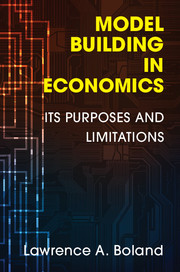Book contents
- Frontmatter
- Dedication
- Contents
- Preface
- Acknowledgements
- Prologue: Model building yesterday versus today
- Part I Theoretical Models
- 1 Microeconomic versus macroeconomic theoretical model building
- 2 On the limitations of equilibrium models in general
- 3 On building theoretical models using game theory
- 4 On the purpose and limitations of game-theoretic models
- Part II Empirical Models
- Part III Testing and Models
- Part IV Methodological Considerations
- Bibliography
- Name index
- Subject index
1 - Microeconomic versus macroeconomic theoretical model building
Published online by Cambridge University Press: 05 October 2014
- Frontmatter
- Dedication
- Contents
- Preface
- Acknowledgements
- Prologue: Model building yesterday versus today
- Part I Theoretical Models
- 1 Microeconomic versus macroeconomic theoretical model building
- 2 On the limitations of equilibrium models in general
- 3 On building theoretical models using game theory
- 4 On the purpose and limitations of game-theoretic models
- Part II Empirical Models
- Part III Testing and Models
- Part IV Methodological Considerations
- Bibliography
- Name index
- Subject index
Summary
When we approach the study of business cycle with the intention of carrying through an analysis that is truly dynamic … we are naturally led to distinguish between two types of analyses: the micro-dynamic and the macro-dynamic types. The micro-dynamic analysis is an analysis by which we try to explain in some detail the behaviour of a certain section of the huge economic mechanism, taking for granted that certain general parameters are given …
The macro-dynamic analysis, on the other hand, tries to give an account of the fluctuations of the whole economic system taken in its entirety. Obviously in this case it is impossible to carry through the analysis in great detail. Of course, it is always possible to give even a macro-dynamic analysis in detail if we confine ourselves to a purely formal theory.
Ragnar Frisch [1933a, p. 2, emphasis in original]One of the functions of theoretical economics is to provide fully articulated, artificial economic systems that can serve as laboratories in which policies that would be prohibitively expensive to experiment with in actual economies can be tested out at much lower cost. To serve this function well, it is essential that the artificial ‘model’ economy be distinguished as sharply as possible in discussion from actual economies. …
Any model that is well enough articulated to give clear answers to the questions we put to it will necessarily be artificial, abstract, patently ‘unreal’.
Robert Lucas [1980, p. 696]- Type
- Chapter
- Information
- Model Building in EconomicsIts Purposes and Limitations, pp. 19 - 45Publisher: Cambridge University PressPrint publication year: 2014



